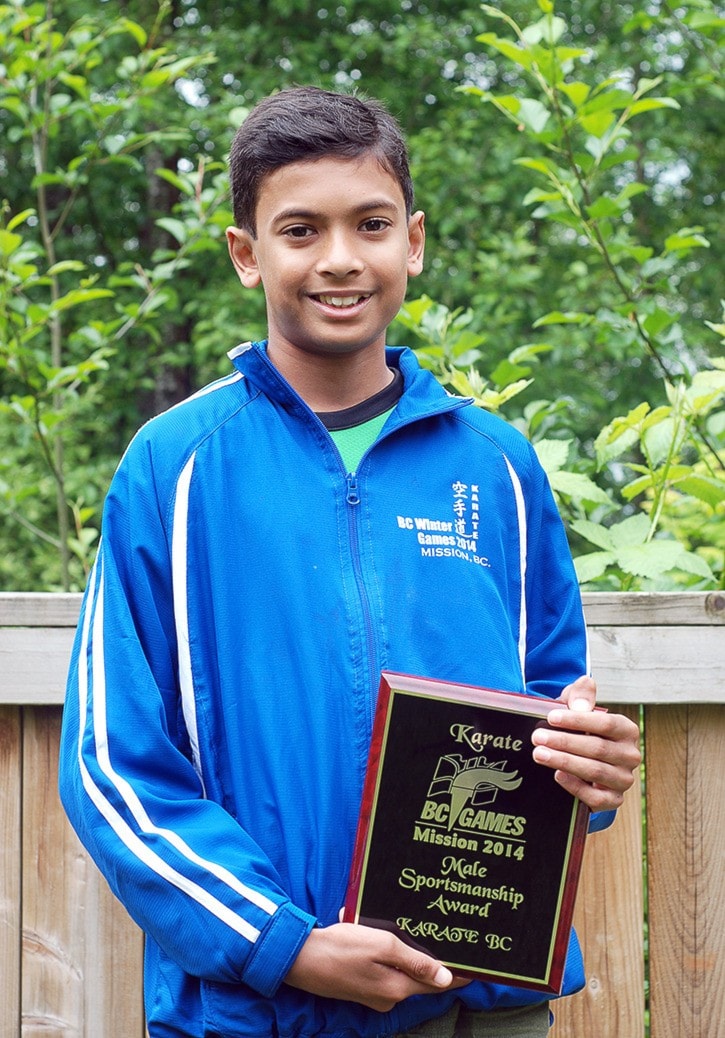It was a Friday in January — his birthday — when 13-year-old Swaraj Aravindhan returned to school and dojo karate training, after being sick with flu-like symptoms for several days.
It would be less than 48 hours before he would be admitted to B.C. Children’s Hospital, paralyzed from the waist down due to an extremely rare and often permanently debilitating condition affecting his spinal cord.
At the time, Swaraj was feeling better, excited to celebrate with his friends and karate teammates, who were practicing for the fast-approaching B.C. Winter Games.
“Later that evening we went to training,” says Swaraj’s dad, Aravindhan Ravindran. “And when he came back he was complaining of a lot of leg pain.
“He has a tendency to push himself, so we thought probably that’s what it was,” adds Ravindran, speaking on the porch of the family’s home in Fort 91ԭ��. Mother, Lakshmi, and little sister, Sulakshana, look on intently while he tells the story.
Swaraj’s condition quickly deteriorated.
“The next day my leg started to kind of feel funny, like it hurt,” explains the Meadowridge School student.
“That was the Saturday, and on Sunday when I woke up, I couldn’t walk.”
“All of a sudden he was crawling,” says Ravindran, adding that when they rushed their son to emergency at 91ԭ�� Memorial Hospital doctors found that he also was retaining one litre of fluid after not being able to relieve his bladder.
“He couldn’t feel anything.”
In 91ԭ�� doctors confirmed that Swaraj was indeed paralyzed and he was transferred to B.C. Children’s.
Still, Swaraj says that at the time, more than anything else, he was feeling sad —worried about missing school and the upcoming tournament, which is only open to 12- and 13-year-olds.
He missed that competition, but at the end of May the dojo student of two years will take part in the Karate B.C. Provincial Championships in Richmond, having made a nearly full recovery that his parents largely credit to his motivation to return to the sport he loves.
Swaraj was diagnosed with transverse myelitis, a rare inflammation of the spinal cord that often targets the insulating material that covers nerve cell fibres, also known as myelin.
The immune condition disrupts transmission of nerve signals, which can cause pain, sensory problems, weakness, and even paralysis — as was the case with Swaraj.
According the Mayo Clinic, exact causes of transverse myelitis are not yet known, although viral and other infections, along with immune system disorders, are thought to trigger the condition.
“The doctors think that it’s from after his infection there was some immune response, which affected his spinal cord and inflamed it,” explains Ravindran, who is, himself, a doctor.
“It’s not very common ... it was quite a scary experience to be on the other side,” he says.
Most patients recover at least partially, but in general prognosis for complete recovery isn’t good, says the Canadian Transverse Myelitis Association on their website.
A full one third of patients are left with major disabilities and virtually no recovery, experiencing long-term pain and partial or total paralysis.
“The doctors told us not to have our hopes high,” says Ravindran. He says that while doctors raced to diagnose and treat the disease — using high doses of steroids and blood filtration to remove harmful immune antibodies — they confided in the shaken parents that there was a chance the paralysis could progress upwards, affecting Swaraj’s chest and breathing.
“To see him like that was very difficult,” says Lakshmi, admitting that in the hopes of keeping his spirits high, the parents didn’t share the full severity of Swaraj’s condition with him until he entered physical rehab later.
While his parents worried about whether he would ever regain function in his legs, Swaraj remained, through a fog of morphine and severe nerve pain, concerned about missing school, dojo practice and his friends.
After two weeks in the hospital the combination of treatments began to work, and small flickers of movement could be seen in the boy’s legs, says Swaraj’s father.
But they still didn’t know if, and how much, Swaraj would recover, and there was still two weeks of intensive in-patient rehabilitation to go.
Through the ordeal, members of Swaraj’s karate group, Walnut Grove’s KimNik Shotokan Karate Academy, visited the hospital to help provide motivation. One student even presented the 13-year-old with his personal black belt.
“His first one, from Japan,” interrupts Swaraj as his dad starts to tell the story. “He [brought] it and gave it to me and he said, ‘You can only give it back when you’re up and walking.’”
Swaraj did just that, walking back into dojo practice a little more than two months after being admitted to hospital.
His parents and physiotherapists credit his unwavering motivation, positive attitude and increased agility and flexibility from karate with aiding his remarkably fast recovery.
“That motivation definitely played a huge role,” says Ravindran.
Today Swaraj says he feels that he is almost back to full health.
“Maybe out of 100, maybe 98 or 99 percent,” he says, explaining that although he still needs to work on his balance and endurance, he hopes to one day earn a black belt for himself, standing firm on his own two feet.



